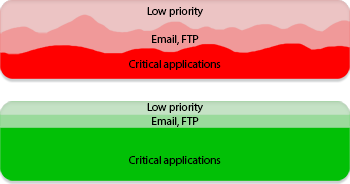Wireless AC Explained
- Do you have issues getting a full Wi-Fi signal?
- Are you always being told to wait while your computer connects?
- Do you have areas in your home where there is no Wi-Fi signal at all?
Most people will have the same router that came with their broadband package, which may be based on old or cheaper technology. As a result you may experience slow speeds and poor internet signal.

Congestion
The average household has an average of 7 Wi-Fi enabled devices. Too many devices trying to connect to the same wireless network at the same time can cause congestion. You can see this when you have continual buffering while you are trying to watch videos on your smart TV, smartphone/tablet or computer, especially when other devices are surfing the web or playing online games at the same time.
All D-Link Wireless AC routers support dual-band or even triple-band wireless, operating on both the 2.4 GHz and the 5GHz wireless bands. This allows you to browse the web, chat and e-mail using the 2.4 GHz band on your smartphone and computer while simultaneously streaming HD videos or gaming online on the 5 GHz band.

Interference
Many household appliances can cause wireless interference, even if they are not Wi-Fi enabled. The list includes cordless phones, baby monitors, and microwave ovens.
You may experience poor network performance caused by this non-wifi interference and in some cases your wireless network may even cut out when the microwave or cordless phone is in use.
To help reduce interference with Wi-Fi, try to position your router away from these appliances and switch to the 5Ghz band.

The solution - Wireless AC. Greater coverage and speed
The simplest solution to solving poor Wi-Fi performance is to switch to Wireless AC. The 802.11ac wireless standard broadcasts on the entire 5 GHz spectrum, where there is less congestion, noise, and interference from competing technologies.
Moreover, there is a lot more space available in this band, allowing for up to 19 channels compared to just three with 802.11n. Plus, AC Wi-Fi channels are wider and carry a lot more data, giving you a seamless network speed at up to 5334 Mbps*.
Discover our Wireless AC routers
Dual and Triple Band Connectivity
Dual-Band Wireless AC Routers have the ability to broadcast on two different frequencies: 2.4GHz and 5GHz. Not only does this make it backwards compatible, but it also means that they are less prone to interference from other devices.
You can browse the Internet on the 2.4GHz band while streaming HD movies on the 5GHz band and neither band will overload. This means less interference and faster speeds.
D-Link's Triple band routers broadcast on one 2.4GHz channel and two channels for the 5GHz band giving you a total bandwidth of up to 5334 Mbps*.

Wireless Signals & Beamforming Technology
The way in which radio signals are transmitted is also changing. Out go omni-directional antennas, broadcasting every which way they can, in favour of “beamforming” technology which aims wireless signals directly at Wi-Fi devices. This provides a much stronger signal that is especially beneficial for mobile devices.

Quality of Service (QoS)
Routers with QoS traffic controls track the type of network traffic (web surfing, online gaming, Skype®, Netflix®) and decide which application deserves higher priority. This improves your online experience by ensuring that high priority traffic like Netflix streaming is prioritised over other network traffic ensuring the best video quality and user experience across all devices on the network.